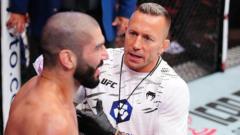Is Hurzeler Concerned About Clubs Targeting Brighton Stars?

Understanding Brighton's Transfer Strategy: Insights from Head Coach Fabian Hurzeler
In the world of football, transfer strategies play a crucial role in shaping a team's future and success. Brighton & Hove Albion, often referred to as the Seagulls, has gained attention not just for their on-field performances but also for their unique approach to player acquisitions and sales. Recently, head coach Fabian Hurzeler shared his insights on the club's transfer philosophy during his appearance on the Monday Night Club. This article delves deep into Hurzeler's perspectives, the intricacies of Brighton's transfer system, and why he remains unfazed by the potential sale of key players.
The Foundation of Brighton's Transfer Strategy
Brighton's transfer strategy is rooted in meticulous planning and a clear vision. The club focuses on developing talent through their youth academy while also scouting for emerging players who can fit into their playing style. This dual approach not only strengthens the squad but also enhances the club's reputation for nurturing talent.
Hurzeler emphasized that the key to their successful transfer system lies in the ability to identify players who possess potential and align with the team's long-term goals. By investing in young talent, Brighton can create a sustainable model that benefits both the club and the players, offering them a platform to showcase their skills on a larger stage.
Why Selling Key Players Isn't a Concern
One of the most intriguing aspects of Hurzeler's discussion was his attitude towards selling key players. Unlike many clubs that might panic at the thought of losing their star performers, Hurzeler expressed confidence in the club's ability to cope with such changes.
- Strategic Planning: The club has a well-established scouting network, allowing them to identify replacements swiftly.
- Player Development: Brighton's youth academy continually produces talent ready to step up when needed.
- Financial Acumen: Selling players at their peak can provide the club with necessary funds to reinvest in their squad.
The Role of Data Analytics in Transfers
In today's modern football landscape, data analytics has become a pivotal tool in shaping transfer decisions. Brighton has embraced this trend, using data to evaluate player performance, potential, and compatibility with the team ethos. Hurzeler noted that data-driven insights help the club make informed decisions, minimizing risks associated with player acquisitions.
This analytical approach not only streamlines the recruitment process but also ensures that every signing is a calculated risk. By leveraging technology and data, Brighton can remain competitive in the transfer market, even against clubs with larger budgets.
The Importance of Team Chemistry
Another critical element in Brighton's transfer strategy is maintaining team chemistry. Hurzeler stressed that while acquiring talent is essential, integrating new players into the existing squad is equally important. He believes that successful teams are built on strong relationships both on and off the pitch.
To foster this chemistry, the club emphasizes scouting players who not only possess the required skills but also share similar values and work ethics with their teammates. This holistic approach ensures that new signings can adapt quickly and contribute effectively to the team's objectives.
Brighton's Youth Academy: A Breeding Ground for Talent
Brighton's commitment to developing young players is evident in their investment in the youth academy. The club has produced several notable talents who have gone on to make a significant impact in the first team. Hurzeler highlighted the importance of this academy system in the club's long-term strategy.
By focusing on youth development, Brighton not only secures a steady pipeline of talent but also cultivates a sense of belonging and loyalty among its players. Young players who rise through the ranks tend to have a deeper connection with the club, which can translate into better performances on the pitch.
Challenges in the Transfer Market
Despite Brighton's well-structured approach, the transfer market is fraught with challenges. Hurzeler acknowledged that competition is fierce, with many clubs vying for the same players. Additionally, the unpredictability of player performance and market fluctuations can complicate transfer dealings.
To navigate these challenges, Brighton relies on its strong scouting network and in-depth market analysis. By staying ahead of trends and understanding market dynamics, the club aims to make strategic decisions that align with their long-term vision.
Future Aspirations for Brighton
As Brighton continues to evolve under Hurzeler's leadership, the club's aspirations remain clear. The goal is to establish themselves as a consistent top-tier team and to compete for European spots regularly. This ambition is fueled by their commitment to smart recruitment and effective player development.
Hurzeler envisions a future where Brighton can attract high-caliber players while maintaining their identity and ethos. By creating a winning culture, the club aims to become a destination for players seeking to develop their careers.
Conclusion
Brighton & Hove Albion's transfer philosophy, articulated by head coach Fabian Hurzeler, offers a refreshing perspective on player recruitment and development. By focusing on youth, data analytics, and maintaining team chemistry, the club has set itself up for success in an ever-evolving football landscape. The ability to sell key players without fear speaks volumes about their confidence in their strategy and the talent within their ranks.
As Brighton continues to navigate the complexities of the transfer market, fans and analysts alike will be watching closely to see how this approach unfolds in the coming seasons. Will Brighton become a consistent contender in the Premier League and beyond? Only time will tell, but their current trajectory suggests that exciting times lie ahead.
FAQs About Brighton's Transfer Strategy
What is Brighton's approach to player recruitment?
Brighton focuses on a combination of youth development and scouting for emerging talent, ensuring a balanced and sustainable squad.
How does data analytics influence Brighton's transfer decisions?
Brighton uses data analytics to evaluate player performance and potential, allowing for informed decision-making in the transfer market.
Why is team chemistry important in transfers?
Team chemistry ensures that new players can integrate smoothly, enhancing overall performance and helping maintain a cohesive unit.
What role does Brighton's youth academy play in their transfer strategy?
The youth academy serves as a crucial pipeline for talent, fostering loyalty and providing players who are ready to contribute to the first team.
What are Brighton's aspirations for the future?
Brighton aims to establish themselves as a consistent top-tier team and compete for European spots regularly while maintaining their identity.
As Brighton continues to evolve, how do you see their transfer strategy impacting their performance in the Premier League? #BrightonHoveAlbion #FootballTransfers #FabianHurzeler
Published: 2025-08-12 11:16:08 | Category: sport


